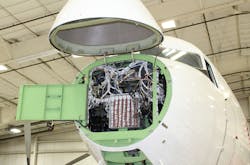Making the old new again is the specialty of Basler Turbo Conversions. Headquartered in Oshkosh, Wisconsin, twice a year Basler Turbo Conversions takes a Douglas C-47 and turns it into a Basler BT-67.
“We have the STC to take the C-47, which is the military version of the DC-3, and essentially take it, gut it, strip it and totally rebuild it,” said Joseph Varkoly, president of Basler Turbo Conversions. “Essentially, it's a new airplane, and in our minds, it really has an indefinite service plan. The thing will fly forever.”
The work they do today is a continuation of the first conversion performed by Warren Basler in 1990 when he replaced the piston engines of his DC-3s with turbines to meet the requirements of a US Mail Service contract.
“The US Mail Service said, ‘Oh, you got to have a turbine-powered engine to move the US mail.’ So he gets this idea of, ‘Well, I'll take one of my DC-3s, tear off the piston engines and bolt on some turbo prop engines." And that's what he did, and low and behold, in 1990 they did the first conversion. And over time, the cargo airline kind of petered out and the conversion business took off,” Varkoly recounts.
Thirty-two years later, Basler is undertaking their 70th conversation at the time of this article’s writing. Varkoly said that they have the capacity to perform two conversions a year, with many conversations being custom tailored to the specific needs of a customer.
“No one else does what we do. We've got the STC to do it … and over the years, we've developed 32 or 33 STCs, and most of those are developed by specific customer needs or customer applications. A customer will say, ‘Hey, can we do this with the airplane?’ And we essentially say, ‘Well, we'll figure it out,’ and we develop an STC to be able to do that specific modification to the aircraft for the customer's needs,” Varkoly said.
Additionally, Basler Turbo Conversions has the PMA authorization to manufacture some 7,000 parts, which are otherwise no longer in production for the Douglas aircraft. As they need parts to replace, Basler fabricates them themselves in house.
“It really is a very vertically integrated company in the conversion process,” said Varkoly. “We do have some subcontract vendors, but we do our own composite work in house, we've got our own fab shop here in house. In short of the avionics that we buy from commercially available folks and communication systems, all the mechanical stuff is really fabricated by our folks here.”
A Modern Aircraft in an Old Frame
The aircraft come from all around the world to be made into BT-67s. Some fly in while many arrive on flatbeds. Varkoly estimates there are likely 600 C-47s left in the world, waiting to be converted.
The conversion process starts by stripping the C-47s down to essentially nothing.
“We pull out all of the hydraulic lines, all of the interiors, all of the electrical wiring, everything comes out of the airplane, and it really is just the aluminum shell that's left,” Varkoly said.
After pressure washing the shell, they examine it for corrosion and start replacing the old with the new.
“Every spar gets replaced regardless, just because of the age of it, and for the zero accumulated fatigue certification that we get from the FAA. It doesn't allow much corrosion at all, so we find it's really quicker and cheaper just to replace it than to try to clean it up and polish it up and continue to use this as a individual spar or any part of the interior of the aircraft. So it really is almost a complete replacement,” Varkoly said.
They take off those piston engines and put on the turbo prop engines, Pratt & Whitney PT-6A67Rs, and because those engines are lighter weight than the piston engines were, the center of gravity of the aircraft moves.
“We literally cut the airplane in half, and we stretch it 40 inches forward of the center wing. So our BT-67s are 40 inches longer than the C-47s were, and because those C-47s are 85 years old, now we gut it and replace literally everything inside the airplane, to the point that 90% of the aircraft is replaced in our conversion process,” Varkoly said.
Varkoly compared the process to taking apart an old jigsaw puzzle and replacing it with new puzzle pieces. As each year the aircraft Basler converts are older and older, the QA requirements continue to ramp up.
There are only some components within the center wing that they’re able to retain, along with the landing gear sometimes.
“When those come in, we'll take them off, we'll mag particle inspect them. We tend to be able to reuse those in most cases, same with the tail wheel, but for the most part everything else gets thrown away and rebuilt,” Varkoly continued. “And when it leaves our facility, you would never guess that airplane first flew in 1943, because it's a brand spanking new thing, which everything on it is new,” Varkoly said.
The entire process takes 50,000 man-hours. The resulting BT-67 is non-pressurized and has the advantage of flying low and slow for a long time.
“So for the right customer in the right niche, there is really not a competitive aircraft out there at the price point that can do what it can do for the size, the payload, the power, the range, the ease of operation, the low cost of maintaining and flying the aircraft, and the overall versatility of it. But it's very much a unique niche aircraft,” said Varkoly.
Filling Niches
Three main markets utilize the BT-67s: military, science and cargo. Varkoly said a lot of foreign militaries operate the aircraft, along with contractors for the U.S. government.
One the largest growth sectors for the BT-67 has been in what Varkoly calls Information, Surveillance and Reconnaissance (ISR).
“Because the airplanes are large on the inside, from a cubic foot perspective, and because they fly and because we're not pressurized, it's easy for us to put a hole in the bottom of the airplane, and our customers can put all sorts of sensors, measuring equipment, cameras, LIDAR equipment,” Varkoly said, adding operations such as border patrols and search and rescue operations are possible uses.
On the scientific side, the BT-67s are often used for geophysical research. The planes have been used for mapping and looking for precious metals, for example.
“When they had the hurricane down in Puerto Rico, our plane went down and essentially, with LIDAR equipment, mapped all of the devastation and destruction down there, and then helped FEMA figure out where are the bridges out, where are the roads most destroyed, and how do they prioritize the rebuilding of the country?” Varkoly said.
The trend Varkoly has seen is that the BT-67 jumps from niche to niche, selling airplanes to a specific segment for a few years, then switching to another the next.
“Right now, for us, that whole ISR marketplace, especially with the geopolitical world that we're living in today, this ISR market, we're seeing a lot of interest from customers and from countries that want to kind of watch what's going on in their borders and watch what's going on around them,” he said.
Customizing the plane to fit these niches often comes down to fuel tanks.
“The biggest variation is whether we put long-range fuel tanks in the wings. The traditional aircraft had fuel tanks just in the center wing, we've modified with an STC that lets us put fuel tanks in the outer wing that literally double the fuel capacity of the airplane, therefore doubling its flight time. So for customers to take advantage of that, that obviously is one difference,” Varkoly said, adding the BT-67 can fly for 12 to 13 hours.
Other than that, customizations can vary from adding spots for equipment such as LIDAR to leaving the body mostly empty for cargo operators.
“We've got an STC to put holes in the belly of the aircraft so that they can put equipment, like a LIDAR unit, and essentially shine it through the bottom of the airplane, and then have workstations with computer stations set up inside the aircraft to gather that information and send it back down to folks on the ground,” Varkoly added.
600 Planes and 50 More Years
Given the number of estimated C-47s left, Varkoly says Basler Turbo Conversions has at least 50 years’ worth of BT-67s to make.
“I think for us, arguably we've been doing the same thing for 30 years. We do one thing, we take a C-47 and we convert it. And that there's enough of them out there for us to do this for 50 more years, and we're taking an airplane that's 80 years old and giving it 80 more years. And I think with that indefinite service life, there will always be a need for this aircraft in the world,” he said.
As they look to those next 50 years, Varkoly said it will be a matter of keeping up with aviation technology as it advances.
“We, as a company, have evolved with the needs of our customer to continue to make the plane serve their needs, so the modifications that we've developed as the years go by continue to get better. The avionics that we put into the aircraft continue to get better,” Varkoly said.
Just this year, Basler Turbo Conversations got an STC for a brand-new auto pilot, effectively giving the BT-67 a glass cockpit.
“It is a very modern airplane in an 80-year-old frame that's been rebuilt,” Varkoly said. “And if you look at the ADSB and all of the things that are making airplane flying safer than it has over the years, we continue to put all those upgrades into our aircraft, and we'll continue to do that in the years to come.”
Varkoly said the entire process of taking the C-47 and turning it into the BT-67 is the most fun job he’s ever had.
“The thing that's cool about this is we're rebuilding something that had a really amazing history and we're giving it a fresh life to do something all over again. And I've really never had the opportunity to do that before, so it's a unique feeling to, again, to see that conversion and to see us rebuild these things and give them a brand-new life. And that's what I think is the coolest part of this,” he said.
About the Author
Walker Jaroch
Editor
Contact: Walker Jaroch
Editor | AMT
+1-920-568-8399
>> To download the AviationPros media kits, visit: Marketing Resource Center
>>Check out our aviation magazines: Ground Support Worldwide | Airport Business | Aircraft Maintenance Technology

